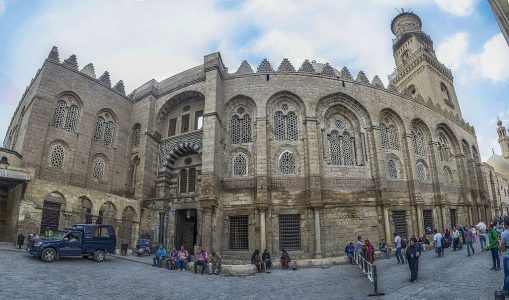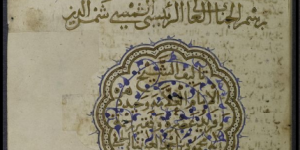I. Manuscript’s Features
Manuscript: Princeton University Library Islamic Manuscripts, Garrett no. 570H Place of origin: Cairo, Language: Arabic. Collation statement stating that the text has been collated with a copy dated 881 Hijri [1476 AD] (Garrett 570H, fol. 292v, lower margin).
Title: Kitāb Taʼsīs al-ṣiḥḥah bi-sharḥ al-Lamḥah (تأسيس الصحة بشرح اللمحة) [A medieval medical reference] Author: Abū Saʻd ibn Abī Surūr al-Sāwī al-Isrāʼīlī ibn Amīr al-Dawlah Commentators: Maḥmūd ibn Aḥmad ʻAyntābī Al-Ḥanafī Known by the name of Al-Amshaṭi Scribe: Abū al-Wafā Muḥammad ibn Ismāʻīl (Garrett 570H, f.292v).
Known Owners: Original owner (patron): copied for Shams al-Dīn al-Qūṣūnī, chief physician in Cairo (Miṣr) (illuminated title page, Garrett 570H, fol. 1r). Additional owners are: Madyan ibn ʻAbd al-Raḥmān Qūṣūnī (descendants of original owner?), his name is in a small circular seal with floral motif and mention "Madyan" on Garrett 570H, fol. 292v. Muṣṭafá Shawkat name in a circular seal with the inscription on second front flyleaf recto.
Binding and Foliation: Dark brown leather on paper pasteboards for upper and lower covers. Both covers have a central floral gilt pattern and a border consisting of gilt Greek key pattern, with a floral motif in each inner corner. No foliation. Quire modern numbering outside the text area in Arabic numerals (written in English), in pencil on folio recto.
Physical description:
- Support: Paper. Light cream in color. Leaf size: 270 x 175 mm. bound to 268 x 180 mm
- Writing and hands:
- On dry point ruling, textblocks are perfectly aligned with homogenous text layout and continuous word flow.
- Written in elegant medium large naskh script in black ink. Red and green ink are also used within the textblock or in the margins, red underlines, commas (punctuation), or regular-size red ink text, and commonly repeated keywords in bold green larger script.
- White space with slightly wider margins at the top and bottom of all leaves (except for two leaves placed between fol. 63 and 64). Marginalia glosses include:
- Catchword in the inner section of the lower margin on the verso of each leaf.
- Solo (or combinations of two) letters are suffices to incomplete words located in the end of a line. The letters are always in alignment with the word it belongs to (ex. Garrett 570H, f.79r).
- Nota signs in bold red ink, adjacent to headings embedded in the textblock with the same format marks the start of a new section or subject (ex. Garrett 570H, f.260v).
- Notes in at least 3 different writing script styles other than that of the scribe, also in black ink but diagonally allocated in the outer or inner (narrow at codex joint) margins, and interlinear annotations (ex. Garrett 570H, f.3r, f. 4v, f.5r, f.24r).
- Extent: 294 bifolia plus paper pastedown and flyleaves. Each folium includes 27 lines. Traces of corrections can be found performed by numerous methods: (1) by Text crossing in main textblock (ex. Garrett 570H, f.177r and v, f.183r, and in the margins of f. 186r). (2) by erasure in textblock (ex. Garrett 570H, f.177r), and (3) by addition of missing words in side margin (ex. Garrett 570H, f.10r and in f.12v margin).
- Blood (?) (ex. Garrett 570H, f. 29v and f.38v) and liquid stains (ex. f.179r), Pen/ink trials (ex. in second front flyleaf recto and F.180r), and Wax blobs (ex. f.36r, f.235r and f.234v) are found.
Decoration:
Illuminated title page in blue, gold, and some red on fol. 1 recto. A cartouche on the upper part of the page bears the title written in blue(?) on a gold ground and a rinceau in blue. To the left of this cartouche is a small medallion in gold and red. The cartouche and medallion are outlined in blue. The rest of the page has: a central large twelve petal roundel executed in blue and gold and bearing the name of the author in gold, and an inscription in gold outlined in black mentioning the name of the patron. The edges of the textblock and the upper margin of Garrett 570H, fol. 1v are decorated with a floral motif in gold.

A beautifully illuminated title page (fol. 1 recto)
II. Classification
Identification Aids
- Front and back flyleaves include modern-day library added label with the codex’s number in Arabic numerals (written in English with pencil).
- Top of flyleaves (Garrett 570H, f.iir and f.iiv), the codex title and author last name are written in black ink riq’a script (a writing script style different that of the scribe’s).
- Illuminated title page, Garrett 570H, fol. 1r identifies the codex title, author and the intended reader (patron listed by name and profession)
Finding Aids
- In-margins nota signs (combined with the same titles duplicated within the textblock) highlighted using larger script, bolded and colored in red ink are used by the scribe with the purpose of facilitating quick reference to the start of a new heading, section or topic (ex. Garrett 570H, f.260v).
- Regular-size red ink text and underlines most likely have been used by the scribe to highlight significant sentences on the page.
- Larger bold green script used to highlight keywords that are repeated at every section describing a medical case to mark the author’s text related to symptoms or cure/treatment related to the medical case or disease explained. This text highlighting technique is also used to mark the beginning of a quotation from a different author or work.
- No original foliation adopted since this was not common for Arabic codices until the sixteenth century (Bausi, A. et al., 2015), however, the codex includes quire modern numbering outside the text area in Arabic numerals (written in English), in pencil on folio recto.
Clarity Aids
- Ruling in dry-point may have been used to eliminate distraction in a text heavy textblock with small interlinear spacing.
- White space comprises approximately 40% of leave surface area with slightly wider margins at the top and bottom, allowing for both an easier reading experience and space for future additions in the form of readers’ notes.
- Different correction methods for text in the main textblock or marginalia glosses by crossing out text, erasure, or addition of missing words in side margin enhances the reading experience by ensuring the reader is consuming an accurate and updated copy.
- Red commas (punctuation) used only in the Garrett 570H, fol. 1v, fol. 2r, f.293r and f.293v allows for the punctuation stand out for clarity purposes.
- Scribe and readers’ glosses in margins. Clarifying words or phrases, adding alternative interpretations (mostly to highlight more recent terms by later consumers).
Structuring Aids
- White space and margins designed for scribe annotations and readers’ notes allows for page structuring and distinction of text block and any form of complimentary texts.
- Highlighting significant sentences using colored ink to mark for new headings or keywords enabled them to stand out from the rest of the text.
- On-dry point ruling, folia include one textblock each with perfectly aligned, homogenous text layout and continuous word flow.
- Adding the suffices of words at line-ends in the margins prevented the distortion of the textblock’s homogeneity and perfect alignment.

Highlighting significant sentences using colored ink to mark for new headings or keywords enabled them to stand out from the rest of the text.
III. Assessment
Guided by the identification aids noted in this codex, it becomes known that it is a copy of a commentary on al-Lamḥah al-ʻAfīfīyah fī al-ṭibb, a work on medicine by Jewish Arab physician; Abū Saʻd ibn Abī Surūr al-Sāwī al-Isrāʼīlī ibn Amīr al-Dawlah copied by an identified scribe for a high ranking official in Cairo’s local hospital: Shams al-Dīn al-Qūṣūnī, the chief physician during the reign of Memluk Sultan Al-Ashraf Barsbay in medieval Cairo (Egypt). Mamluks were known to have profoundly developed the medical infrastructure in Cairo by establishing awqaf (endowments, sing. waqf) which included hospitals (Fancy, N., 2013), most notably Dar ElShifa – al-bimaristan al-Mansouri.

Mansour Qalawun complex in Muiz street, Cairo, Egypt which comprised al-bimaristan al-Mansouri. [Source: Ma7moudsmile on Wikipedia licensed under CC BY 4.0]
The intended use of this codex may be deduced from investigating and analyzing the multiple traces of use, and linking them to the nature and context of the profession of the patron to whom this copy has been created. Knowing that the profession and title of the original patron and user of this codex is the Egyptian chief physician, enables us to understand that the codex in hand was most probably not intended for to be used as a medical study textbook, but rather a reference of a different kind. The traces of (possible) blood stains, may suggest a practical dimension to the use of the codex, in fact it is very likely that it was even designed to act as a medical handbook intended for use by physicians during their practice, among other possible settings.
Given it most likely served as a handbook of a fast-evolving discipline such as medicine, the extensive marginalia come as no surprise. Analyzing the type of activity performed in the margins, most likely by the many readers/users of this codex, indicate heavy additions in the form of notes many of which could be identified as updated terminology or methodology, corrections (by crossing out) in the main textblock or in preceding annotations by readers/users from older (outdated) times.
Margins are not extensive allowing for medium amount of readers’ or scribe additions. It seems that the scribe predictions were, to a great extent, true. Where most of the folia included readers’ annotations (marginalia other than scribe notes and clarifications), few folia included extensive additions (Garrett 570H, f.4v included the most marginalia accounting to approximately 90% of the folium’s white space) and the vast majority included few to medium additions (and all with smaller script size with comparison to the scribe’s formatting size). This considerate margin note-taking behaviour manifested by the numerous readers suggest a profound culture of book re-use and the passing of books along different generations of readers. Readers were most likely keen on mindfully using books which they are most likely going to either trade or pass on to family members for further use. The dates of production and successive uses indicate that the codex continued to circulate in the local book market for more than 200 years before it was owned by a European collector, Robert Garrett in 1900, followed by the University of Princeton.

Extensive marginalia could be found in different scripts indicating multiple users of the codex.
Considering the rank of its intended (original) patron of the copy in hand and the illumination used to decorate the title page, it is not hard to conclude that it was carefully produced to be of high value (and accordingly price). The codex, however, outlived its original esteemed patron and was passed on from owner/user to another (which could be traced by observing the signatures and ownership notes of its successive users on the flyleaves). Interestingly, it has most likely circulated in one family for a long time which can be presumed from the identical last names of two of the three identified owners.
Lastly, the Greek patterns on the brown leather binding suggest that it is not likely to be original but rather added at a much later stage most probably by Robert Garrett, or even later by the first library that acquired it.
Reference
Bausi, A., Borbone, P. G., Briquel-Chatonnet, F., Buzi, P., Gippert, J., Macé, C., Sokolinski, E. (Eds.). (2015). Comparative Oriental manuscript studies: An introduction. Hamburg: Tredition Gmbh.
The British Library. (n.d.). Catalogue of illuminated manuscripts: Glossary. Retrieved from: https://www.bl.uk/catalogues/illuminatedmanuscripts/glossary.asp
Fancy, N. (2013). Science and religion in Mamluk Egypt: Ibn al-Nafis, pulmonary transit and bodily resurrection. London: Routledge.
Kwakkel, E. (2018). Books before print. Leeds: ARC Humanities Press.
Priceton University. (n.d.). Princeton University Library Catalog. Retrieved from: https://catalog.princeton.edu/catalog/5081950#view

Learning Significance